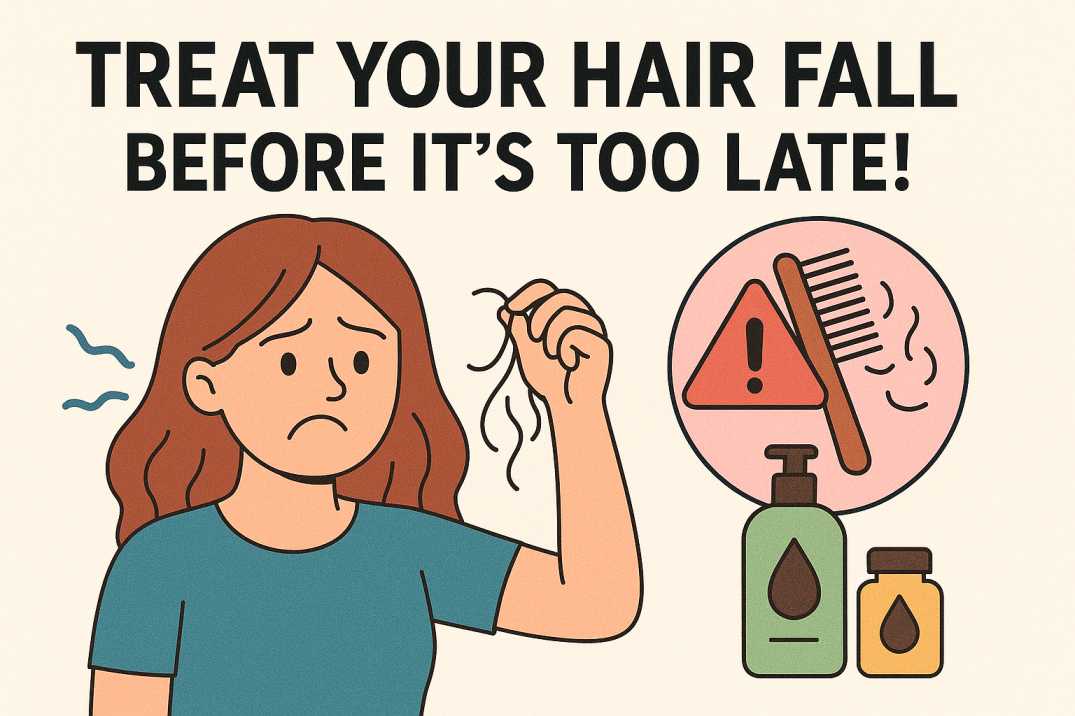Treat Your Hair Fall Before It's Too Late!

Hair Loss Is a Wake-Up Call You Shouldn’t Ignore
Hair loss is more than just a cosmetic issue—it can be a sign of underlying health concerns, poor hair care routines, or environmental stressors. Many people don’t take hair fall seriously until it's too late. By understanding the causes and adopting a proactive approach, you can protect your hair and confidence. In this guide, we'll explore the best ways to stop hair loss and provide effective hair care tips.
Understanding Hair Loss: Causes and Early Warning Signs
Hair loss, medically known as alopecia, is a condition that affects millions of individuals globally. While it is often considered a natural part of aging, it can also be a sign of underlying health conditions, lifestyle factors, or environmental stressors. Understanding the causes and early warning signs of hair loss is critical in addressing the problem proactively and preventing it from progressing to permanent baldness.
Common Causes of Hair Loss
Hair loss can be triggered by a variety of internal and external factors. Recognizing the root cause is the first step toward finding the right solution.
1. Genetic Predisposition (Androgenetic Alopecia)
The most common form of hair loss is genetic, often referred to as male-pattern baldness or female-pattern baldness. It occurs due to a genetic sensitivity to dihydrotestosterone (DHT), a derivative of testosterone, which shrinks hair follicles over time. This leads to progressively thinner hair and eventual baldness, especially around the crown and hairline in men and thinning across the scalp in women.
2. Hormonal Imbalances
Fluctuations in hormones can greatly impact hair health. Conditions such as thyroid disorders, polycystic ovary syndrome (PCOS), menopause, and even pregnancy can lead to temporary or permanent hair shedding. Hormonal treatments or birth control pills may also contribute to hair loss.
3. Stress and Anxiety
High levels of emotional or physical stress can lead to a type of hair loss called telogen effluvium, where hair prematurely enters the shedding phase. Events such as surgeries, illness, accidents, or traumatic experiences can shock the hair cycle, causing a significant increase in hair fall 2–3 months after the event.
4. Nutritional Deficiencies
Poor diet can directly impact the strength and growth cycle of your hair. Deficiencies in iron, zinc, vitamin D, biotin, and protein are closely associated with hair thinning. Crash dieting, excessive fasting, or eating disorders can deprive hair follicles of essential nutrients.
5. Overuse of Chemicals and Heat Styling
Frequent use of harsh chemical treatments such as hair coloring, bleaching, perm solutions, and keratin straightening can weaken hair shafts and irritate the scalp. Likewise, excessive use of hot styling tools like straighteners, curling irons, and blow dryers can lead to heat damage, causing hair to become brittle and prone to breakage.
6. Medical Conditions and Medications
Certain health conditions such as autoimmune diseases (e.g., alopecia areata), lupus, scalp infections, and anemia can result in hair loss. Additionally, medications for cancer (chemotherapy), depression, high blood pressure, and heart diseases often list hair loss as a side effect.
Early Warning Signs of Hair Loss
Detecting hair loss early can make a significant difference in treatment outcomes. Here are the most common early signs to watch for:
1. Increased Hair on Pillow or Shower Drain
Noticing more strands than usual on your pillow, hairbrush, or shower drain can be one of the first indicators. While shedding 50–100 hairs per day is normal, anything beyond that could signal a problem.
2. Widening Part Line or Thinning Crown
A subtle increase in the width of your part or a more visible scalp on the crown area may suggest early female-pattern hair loss. Men may notice a receding hairline or thinning at the temples.
3. Excessive Breakage
If your hair snaps off easily when brushing or styling, you may be experiencing shaft breakage rather than root loss, often caused by heat or chemical damage.
4. Scalp Irritation or Flakiness
Persistent itching, redness, or dandruff can weaken the follicles and indicate scalp inflammation, which may lead to hair loss if not treated promptly.
5. Slow Hair Growth
If your hair seems to grow slower than usual, it could be an early sign of reduced follicle activity due to stress, hormonal changes, or nutritional deficiencies.
Why Early Detection Matters
Hair follicles go through a life cycle: growth (anagen), rest (telogen), and shedding (catagen). When an imbalance occurs—due to any of the reasons above—the follicles prematurely enter the resting or shedding phase. If the root cause is not addressed in time, the follicle may shrink and eventually stop producing hair altogether.
Early detection allows for less aggressive treatments such as topical applications, dietary changes, or non-invasive therapies to reverse or slow the process. Waiting too long may limit your options to only clinical or surgical interventions like PRP therapy or hair transplants.
Daily Hair Care Tips to Prevent Hair Loss
When it comes to combating hair loss, prevention is always better than cure. Your daily hair care routine plays a vital role in maintaining the health of your hair and scalp. Even small habits—when practiced consistently—can reduce hair fall and promote strong, shiny, and resilient hair. Below are practical, evidence-based tips to help prevent hair loss effectively.
1. Use a Mild, Sulfate-Free Shampoo
Many commercial shampoos contain sulfates and parabens that strip your scalp of its natural oils. This leads to dryness, irritation, and hair breakage. Instead, opt for sulfate-free shampoos formulated for your hair type. These are gentler and maintain the natural pH balance of your scalp.
💡 Tip: Look for ingredients like aloe vera, biotin, keratin, or tea tree oil to nourish the scalp.
2. Wash Hair Regularly – But Not Excessively
Keeping your scalp clean is crucial to remove dirt, sebum, and product buildup that can clog hair follicles. However, over-washing can strip the hair of its protective oils.
For oily scalps: wash every 2 days.
For dry or curly hair: 2–3 times a week is sufficient.
3. Avoid Hot Water; Use Lukewarm Instead
Washing your hair with hot water can damage hair cuticles, making strands brittle and prone to breakage. Lukewarm or cool water helps retain moisture and adds natural shine.
4. Condition Properly
Never skip conditioner after shampooing. A good conditioner seals the hair cuticle, reduces tangling, and prevents split ends.
Apply only on the hair length—not the scalp.
Use a deep-conditioning hair mask once a week.
5. Use a Wide-Tooth Comb
Wet hair is at its weakest. Always use a wide-tooth comb to gently detangle your hair when damp. Avoid using fine brushes or combs that pull on the roots.
6. Limit Heat Styling and Chemical Treatments
Frequent use of flat irons, curlers, and blow dryers weakens hair proteins and causes thermal damage. Similarly, chemical straighteners, bleach, and dyes break down hair structure.
🛑 Limit heat styling to once a week and always use a heat protectant spray.
7. Avoid Tight Hairstyles
Hairstyles like ponytails, braids, or buns—when worn tightly—can cause traction alopecia, a form of hair loss due to tension on hair follicles. Opt for loose, comfortable styles.
8. Sleep on a Silk Pillowcase
Cotton pillowcases cause friction and absorb natural hair oils. Silk or satin pillowcases reduce breakage and frizz, keeping hair healthier overnight.
9. Keep Your Scalp Moisturized
A hydrated scalp promotes better follicle function. Apply coconut oil, jojoba oil, or argan oil weekly to nourish and balance the scalp.
10. Protect Hair from Sun and Pollution
UV rays and environmental pollutants can damage hair cuticles. When stepping out, wear a hat or scarf to shield your hair.
Best Ways to Stop Hair Loss Naturally
Hair loss can be distressing, but many people are turning to natural remedies to manage and reverse the problem without depending on harsh chemicals or medications. Natural treatments not only reduce hair fall but also nourish the scalp and restore vitality to your hair. Here are some of the best ways to stop hair loss naturally using time-tested methods.
1. Aloe Vera: The Soothing Healer
Aloe vera has anti-inflammatory and enzymatic properties that help in treating scalp conditions like dandruff and dryness. It balances the pH level of your scalp and promotes healthier follicles.
How to use:
Extract fresh aloe vera gel.
Apply directly to the scalp.
Leave for 30–60 minutes before washing off.
Repeat 2–3 times a week for best results.
2. Coconut Oil Massage
Coconut oil is rich in medium-chain fatty acids that penetrate deep into the hair shaft. It moisturizes, prevents protein loss, and strengthens roots.
How to use:
Warm the oil slightly and massage it into your scalp for 5–10 minutes.
Leave overnight or at least 1 hour before washing.
Do this twice a week for visible improvement in hair texture and reduced fall.
3. Onion Juice: High Sulfur Content for Growth
Though pungent in smell, onion juice is a powerful hair growth booster. Its high sulfur content improves blood circulation and stimulates follicles.
How to use:
Blend and strain one onion to extract juice.
Apply to scalp using a cotton ball.
Leave for 15–30 minutes and rinse with mild shampoo.
Apply 1–2 times per week.
🔗 Read scientific studies supporting onion juice efficacy (National Library of Medicine)
4. Fenugreek (Methi) Seeds
Fenugreek seeds are packed with protein and nicotinic acid, which rebuild hair structure and strengthen follicles.
How to use:
Soak 2 tablespoons overnight.
Grind into a paste and apply to scalp.
Leave for 30 minutes, then rinse thoroughly.
Repeat once a week.
5. Green Tea Rinse
Green tea is full of antioxidants that combat hair loss and improve growth by blocking DHT (a major cause of hair fall).
How to use:
Brew 2 green tea bags in hot water.
Cool and use as a final rinse after shampooing.
Use 2–3 times a week.
6. Indian Gooseberry (Amla)
Amla is rich in Vitamin C and antioxidants that boost collagen production and stimulate hair growth.
How to use:
Mix amla powder with coconut oil or yogurt.
Apply as a hair mask for 30 minutes.
It reduces premature graying and nourishes the scalp.
7. Balanced Diet and Hydration
Even the best natural treatments won’t work if your nutrition is lacking. Focus on consuming:
Protein (eggs, fish, legumes)
Iron (spinach, lentils)
Zinc & Biotin (nuts, seeds)
Vitamin E & D (sunlight, almonds, mushrooms)
Stay hydrated by drinking at least 2–3 liters of water daily.
8. Scalp Massage
A 5-minute scalp massage stimulates blood flow, reduces stress, and activates follicles. You can massage with oils or simply use your fingers.
Bonus: Try using a jade roller or scalp massager for better effect.
9. Avoiding Toxins and Harsh Products
Many hair products contain parabens, phthalates, and alcohols that harm your scalp. Always check the ingredients and opt for organic or Ayurvedic options.
10. Manage Stress Effectively
Chronic stress disrupts hormone levels, causing hair to fall. Incorporate meditation, yoga, or mindfulness exercises into your daily routine to maintain hormonal balance.
The Role of Diet in Hair Health
When it comes to healthy, strong, and vibrant hair, what you put on your plate is just as important as what you put on your scalp. Hair is primarily made up of a protein called keratin, and like every other part of your body, it requires a steady supply of essential nutrients to grow and thrive. An imbalanced diet can be one of the most overlooked causes of hair loss and thinning. Consequently, a nourishing, nutrient-dense diet plays a critical role in stopping hair loss and maintaining optimal hair health.
Let’s explore how your diet directly influences your hair and which nutrients are most important.
1. Protein: The Building Block of Hair
Hair is composed of keratin, a type of protein, which makes dietary protein essential for hair structure and growth. Without adequate protein, your body prioritizes vital organs over hair follicles, resulting in hair fall and slower growth.
Best sources of protein:
Eggs
Fish (like salmon and tuna)
Chicken and turkey
Lentils, beans, and chickpeas
Greek yogurt and low-fat dairy
🔎 Tip: Include at least one high-protein food in every meal to support keratin production.
2. Iron: Oxygen Carrier for Hair Follicles
Iron deficiency is one of the leading causes of hair loss, especially in women. Iron helps red blood cells deliver oxygen to cells, including those responsible for hair growth. Low levels can disrupt the hair growth cycle, leading to shedding.
Iron-rich foods:
Spinach, kale, and other leafy greens
Red meat and organ meats (like liver)
Pumpkin seeds
Tofu
Fortified cereals
Pair iron-rich foods with vitamin C sources (like citrus fruits) to boost absorption.
3. Omega-3 Fatty Acids: Anti-Inflammatory Support
Omega-3 fatty acids are essential fats that our body cannot produce. They nourish the hair, support hair thickening, and reduce inflammation of the scalp, which may trigger hair fall.
Sources of Omega-3:
Fatty fish (salmon, sardines, mackerel)
Flaxseeds and chia seeds
Walnuts
Avocados
Omega-3 enriched eggs
📌 A healthy scalp environment is key to maintaining strong hair roots.
4. Zinc: Follicle Maintenance Mineral
Zinc plays a vital role in tissue growth and repair, including hair follicles. It helps maintain the oil glands around the follicles, reducing scalp dryness and dandruff.
Zinc-rich foods:
Pumpkin seeds
Cashews and almonds
Chickpeas
Beef and shellfish
Whole grains
Deficiency in zinc can lead to hair shedding and a flaky scalp.
5. Biotin (Vitamin B7): The Hair Growth Vitamin
Biotin is often recommended for hair loss as it improves keratin infrastructure and supports new cell generation. While biotin deficiencies are rare, even mild shortages can lead to thinning hair or brittle strands.
Top biotin sources:
Eggs (especially yolks)
Almonds
Sweet potatoes
Spinach
Bananas
6. Vitamin D: Hormonal Balance and Follicle Health
Vitamin D stimulates hair follicles and plays a role in creating new follicles. A deficiency in this vitamin has been linked to alopecia areata and other hair loss conditions.
Natural sources:
Sunlight (15–20 mins/day)
Mushrooms
Fortified milk and orange juice
Fatty fish
Egg yolks
If you live in areas with low sunlight, consider getting your levels tested and supplement if necessary.
7. Vitamin A: Sebum Production and Cell Growth
Vitamin A helps in the production of sebum, an oily substance that moisturizes the scalp and keeps hair healthy. However, excessive Vitamin A can also cause hair loss, so balance is key.
Best sources:
Carrots, pumpkins, and sweet potatoes
Mangoes
Kale and spinach
Red peppers
Liver (in moderation)
8. Vitamin E: Hair Repair and Shine
Vitamin E is a powerful antioxidant that helps reduce oxidative stress on the scalp and supports capillary circulation, aiding in stronger, shinier hair.
Vitamin E sources:
Almonds
Sunflower seeds
Spinach
Avocados
Olive oil
9. Hydration: A Key Factor in Hair Elasticity
While it’s easy to focus on food, hydration is often underestimated. Dehydration causes dry, brittle hair and weak roots, which increases breakage and hair fall.
Hydration tips:
Drink at least 8–10 glasses of water daily
Include water-rich fruits and vegetables like cucumber, watermelon, and oranges
Limit caffeine and sugary drinks which dehydrate your body
10. Foods to Avoid for Hair Health
Certain foods can negatively impact hair health if consumed excessively:
Refined sugar: Leads to insulin spikes and hormonal imbalance
Excess salt: Dehydrates hair follicles
Alcohol: Reduces zinc and dehydrates scalp
Processed foods: Lack essential nutrients and increase inflammation
Scalp Care: The Foundation of Healthy Hair
When it comes to achieving strong, shiny, and voluminous hair, many people focus solely on hair strands — choosing the right shampoo, conditioner, and serums. However, the true secret to healthy hair starts at the scalp. A nourished, clean, and balanced scalp provides the ideal environment for hair follicles to thrive, promoting natural hair growth and reducing breakage and shedding.
Let’s explore why scalp care is crucial and how you can build a daily or weekly routine to improve the health of your hair from the roots.
Why Is Scalp Care Important?
Your scalp is essentially the “soil” from which your hair grows. If the scalp is dry, oily, inflamed, clogged with product build-up, or lacking in nutrients, your hair will suffer the consequences. Problems like dandruff, itchiness, slow hair growth, excessive shedding, and thinning hair often stem from an unhealthy scalp.
Just as skincare maintains glowing skin, scalp care maintains healthy hair growth cycles by:
Boosting blood circulation
Preventing clogged hair follicles
Reducing inflammation and dandruff
Maintaining proper moisture balance
Improving absorption of hair oils and treatments
Key Signs Your Scalp Needs Attention
Persistent itchiness or dryness
Flaky scalp or dandruff
Oily or sticky roots even after washing
Redness, bumps, or scalp acne
Noticeable increase in hair shedding
Hair looking dull, lifeless, or not growing as fast
Daily & Weekly Scalp Care Tips
1. Keep Your Scalp Clean – But Don’t Overwash
Clean your scalp regularly to remove dirt, sweat, and product residue, but avoid over-washing, which can strip natural oils and cause dryness.
🗓 Frequency: 2–3 times a week (or as per your scalp type)
Use a mild, sulfate-free shampoo that suits your scalp condition:
For dry scalp: Use moisturizing or anti-dandruff shampoo with tea tree oil or aloe vera
For oily scalp: Use a clarifying shampoo with salicylic acid or charcoal
2. Exfoliate Your Scalp Weekly
Just like facial exfoliation, scalp exfoliation removes dead skin cells and boosts blood flow, promoting hair growth.
Use a gentle scrub or chemical exfoliants (like AHAs/BHAs) once a week.
DIY Option: Mix brown sugar with coconut oil and massage gently in circular motions.
3. Scalp Massage: Stimulate Hair Follicles
Massaging your scalp for just 5–10 minutes daily improves blood circulation and stimulates hair follicles. Use your fingertips or a scalp massager tool.
✨ Add a few drops of rosemary, peppermint, or lavender essential oil to your massage oil for better results.
4. Oil Your Scalp Regularly (But Not Excessively)
Oiling nourishes the scalp, strengthens roots, and adds shine. Opt for oils rich in vitamins and fatty acids:
Coconut oil – deep conditioning & antimicrobial
Castor oil – encourages hair growth
Jojoba oil – balances sebum levels
Rosemary oil – boosts scalp circulation
Massage oil into the scalp and leave it for 30 minutes to overnight, then shampoo thoroughly.
5. Avoid Product Build-Up
Using too many styling products can clog pores and suffocate follicles. Use lightweight, non-comedogenic products and wash hair regularly to prevent build-up.
🧴 Tip: Clarify your scalp once every two weeks with an apple cider vinegar rinse (diluted with water) to balance pH and remove residue.
6. Protect Your Scalp from Environmental Damage
Sun exposure, pollution, and sweat can harm your scalp. Wear a hat or scarf outdoors, especially under harsh sun. Use UV-protectant hair sprays if needed.
7. Maintain a Healthy Scalp pH
A balanced scalp pH (around 4.5–5.5) prevents bacterial or fungal growth. Avoid harsh shampoos and opt for products labeled “pH-balanced” or “gentle.”
8. Treat Scalp Conditions Early
If you suffer from conditions like:
Dandruff or seborrheic dermatitis
Psoriasis or eczema
Fungal infections
Scalp acne or inflammation
…it’s crucial to consult a dermatologist or trichologist early. Treating these issues promptly can prevent long-term hair damage.
Scalp Care Do's and Don'ts
✅ Do:
Massage your scalp regularly
Stay hydrated
Use a silk pillowcase (prevents friction and breakage)
Eat a balanced, nutrient-rich diet
❌ Don’t:
Use hot water to wash your hair (it strips natural oils)
Scratch your scalp aggressively
Use harsh styling gels or sprays directly on the scalp
Ignore early signs of scalp imbalance
Hair Oils and Serums That Actually Work
Look for oils that offer therapeutic benefits:
Castor Oil: Rich in ricinoleic acid for growth
Argan Oil: Moisturizes and restores elasticity
Jojoba Oil: Mimics the scalp’s natural oils
Biotin-Infused Serums: Strengthen strands and reduce breakage
Choose products free from parabens and sulfates.
Stress and Hair Fall: The Unseen Connection
Chronic stress impacts hormonal balance and leads to telogen effluvium (hair shedding). Effective stress management includes:
Yoga and meditation
Proper sleep (7-9 hours)
Deep-breathing exercises
Time management and regular breaks
A calm mind promotes a healthy scalp environment.
When to See a Dermatologist or Trichologist
Not all hair fall can be treated at home. Seek professional help if:
Hair fall persists for more than 3 months
There are bald patches or scalp inflammation
Hair loss follows sudden trauma or illness
Timely diagnosis leads to better outcomes.
Best Medical Treatments for Severe Hair Loss
In some cases, medical treatments become necessary:
Minoxidil (Rogaine): FDA-approved topical treatment
Finasteride: Oral medication for male pattern baldness
PRP Therapy: Platelet-rich plasma injections
Hair Transplant Surgery
These treatments should always be taken under medical supervision.
Myths About Hair Loss You Should Stop Believing
✅ Myth 1: Wearing Hats Causes Hair Loss
Fact: Hats do not cause hair loss. This myth likely stems from the idea that hats reduce blood circulation or suffocate the scalp — both are false. Hair follicles receive nutrients from your blood, not the air.
Unless a hat is extremely tight and consistently pulls on your hair (like a rubber swim cap), wearing hats has no direct effect on hair loss.
✅ Myth 2: Hair Loss Only Affects Men
Fact: Hair loss affects both men and women — just in different patterns. While men often experience receding hairlines and bald spots, women typically suffer from diffuse thinning across the scalp.
Conditions like female pattern hair loss, postpartum shedding, hormonal imbalance, and stress-related hair fall are common in women.
✅ Myth 3: Shampooing Too Often Causes Hair Loss
Fact: Washing your hair does not make you lose it. Hair shedding in the shower is completely normal — we shed around 50–100 hairs daily as part of the natural cycle.
However, using harsh shampoos with sulfates or alcohol can weaken the hair shaft over time. So, while shampooing itself doesn’t cause hair loss, using the wrong products or poor scalp hygiene can.
✅ Myth 4: Cutting Your Hair Makes It Grow Faster
Fact: Hair growth starts at the scalp — not the ends. Trimming your hair doesn't affect follicle activity or the speed of hair growth.
That said, regular trims help reduce split ends and breakage, which makes hair look fuller and healthier as it grows.
✅ Myth 5: Hair Loss Is Always Permanent
Fact: Not all hair loss is irreversible. Many types of hair loss are temporary and treatable, such as:
Telogen effluvium (stress or illness-related)
Postpartum shedding
Nutritional deficiencies
Certain medications
With the right care, diet, and treatments, hair often regrows within a few months.
✅ Myth 6: Hair Oils Can Cure Baldness
Fact: While oils like coconut, castor, and rosemary oil can nourish the scalp and improve circulation, they cannot reverse genetic baldness or revive dead follicles.
They’re great for maintaining healthy hair, but should not be considered a cure for conditions like androgenetic alopecia (male/female pattern baldness).
✅ Myth 7: Stress Causes Immediate Hair Loss
Fact: Stress can lead to hair loss — but not instantly. A stressful event (like illness, surgery, or emotional trauma) can trigger telogen effluvium, a type of hair shedding that usually starts 2–3 months later.
It’s temporary and often resolves once the stressor is managed.
✅ Myth 8: Brushing Your Hair 100 Times a Day Stimulates Growth
Fact: This old myth does more harm than good. Excessive brushing leads to mechanical damage, breakage, and split ends.
Instead, brush gently only as needed — preferably with a wide-tooth comb or soft-bristle brush to reduce tension on the scalp and strands.
✅ Myth 9: Hair Loss Means You’re Sick
Fact: While hair loss can sometimes signal underlying health issues (like thyroid disorders, iron deficiency, or autoimmune conditions), not all hair loss is a sign of illness.
Aging, genetics, hormonal shifts, and poor hair care habits can also be responsible — and most cases are not life-threatening.
✅ Myth 10: Natural Remedies Work for Everyone
Fact: Natural remedies like aloe vera, onion juice, and herbal treatments might help some people, but results vary greatly based on the cause of your hair loss.
If you’re dealing with genetic baldness or hormonal imbalance, you’ll likely need medical treatments like minoxidil, PRP therapy, or hair transplants.
Building a Personalized Hair Care Routine
Tailor your hair care to your specific needs:
Determine your hair type (oily, dry, normal)
Set a weekly routine: wash, condition, mask, oil
Choose products with natural, nourishing ingredients
Avoid over-styling or daily heat use
Consistency is key to seeing long-term results.
Tracking Your Hair Health Progress
Document your journey to stay motivated:
Take monthly pictures of your scalp and hairline
Keep a hair care journal
Note any product reactions or improvements
Celebrate small wins (less breakage, thicker ponytail, etc.)
Tracking helps refine what works and what doesn’t.
Frequently Asked Questions (FAQs)
1. How much hair fall is normal per day?
Around 50 to 100 strands per day is considered normal.
2. Can stress alone cause hair fall?
Yes, chronic stress can lead to temporary hair shedding.
3. How long do natural remedies take to show results?
Most remedies require at least 4-6 weeks of consistent use.
4. Is hair loss reversible?
In most cases, yes, especially if treated early.
5. Can changing shampoo stop hair fall?
Only if the previous shampoo was damaging your scalp or hair.
6. Should I oil my hair daily?
No, 2-3 times a week is enough for most hair types.
7. Are salon treatments good for hair fall?
Some treatments may help, but always check for harsh chemicals.
Take Charge of Your Hair Health Today
Hair loss may feel overwhelming, but it is manageable with the right approach. By following hair care tips, understanding the causes, and taking proactive steps—you can regain your hair and confidence. Remember, prevention is better than cure. Treat your hair fall before it's too late.
If you're concerned about hair fall, don't wait. Start your personalized hair care journey today. Bookmark this guide and share it with someone who needs it.
Powered by Froala Editor
You May Also Like

लखनऊ की बेस्ट डिजिटल मार्केटिंग एजेंसी: टॉप डिजिटल मार्केटिंग सर्विसेज़ 2025 गाइड

Best Social Media Marketing Services | #1 SMM Company in India

How To Boost Your Facebook Subscribers: 10 Proven Strategies to Boost Your Facebook Followers

Best Social Media Marketing Agency in Lucknow | #1 SMM Company SOCIAL MARKET BOOSTER

Best Social Media Marketing Services | #1 SMM Company SOCIAL MARKET BOOSTER

